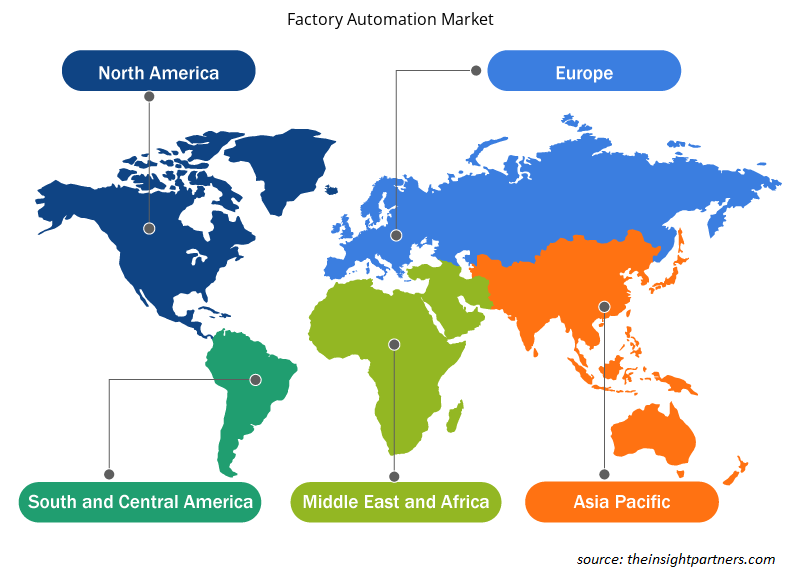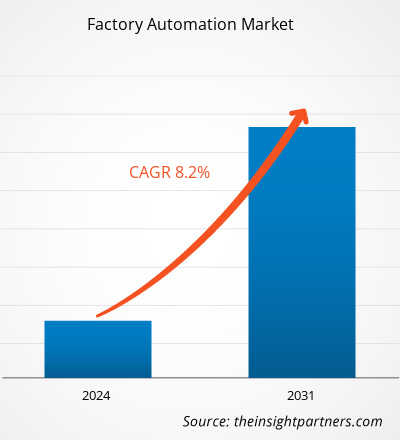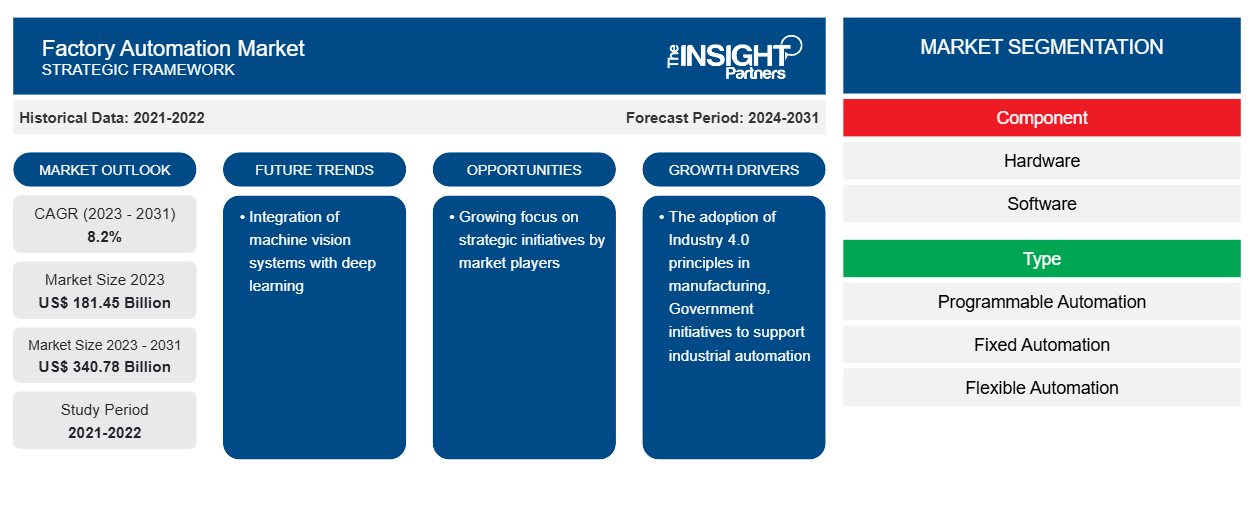공장 자동화 시장은 2023년 1,814억 5,000만 달러에서 2031년 3,407억 8,000만 달러로 성장할 것으로 예상되며, 2023년에서 2031년까지 연평균 성장률 8.2%로 확대될 것으로 예상됩니다. 머신 비전 시스템과 딥 러닝의 통합이 시장의 주요 트렌드가 될 것으로 예상됩니다.
공장 자동화 시장 분석
제조 사업은 지난 10년 동안 빠르게 확장되었습니다. 세계화는 시장을 확대하여 많은 수의 새로운 플레이어를 유치하고 있습니다. 주요 기업의 공장 자동화 시장에서 경쟁 우위는 제품 차별화, 비용 리더십, 타겟 마케팅 및 훌륭한 애프터 서비스를 통해 구축될 수 있습니다. 자동화는 생산 프로세스에 중요한 요소입니다. 또한 고급 자동화 솔루션을 통해 지속적으로 높은 품질, 높은 처리량 및 낮은 생산 비용을 달성할 수 있습니다. 따라서 공장 자동화 시장은 예측 기간 동안 성장할 것으로 예상됩니다.
공장 자동화 시장 산업 개요
공장 자동화는 제조 공정의 모든 단계에 자동화를 통합하는 것입니다. 제조 분야의 자동화는 공압 시스템 , 유압 시스템, 로봇 팔과 같은 기술을 결합하여 보다 복잡한 시스템을 생산하는 경우가 많습니다. 경쟁적인 환경에서 공장 자동화는 비용을 낮추는 동시에 산출량과 효율성을 높이는 데 도움이 될 수 있습니다. 공장 자동화는 빠르게 변화하는 현대 공장 환경에서 효율성, 품질, 지속 가능성, 안전 및 보안을 높이는 매력적인 방법을 제공합니다.
귀하의 요구 사항에 맞게 이 보고서를 사용자 정의하세요
이 보고서의 일부 또는 국가 수준 분석, Excel 데이터 팩을 포함하여 모든 보고서에 대한 사용자 정의를 무료로 받을 수 있으며 신생 기업 및 대학을 위한 훌륭한 혜택과 할인 혜택을 이용할 수 있습니다.
-
이 보고서의 주요 시장 동향을 알아보세요.이 무료 샘플에는 시장 동향부터 추정 및 예측까지 다양한 데이터 분석이 포함됩니다.
공장 자동화 시장 동인 및 기회
시장 성장을 촉진하기 위한 제조업에서의 산업 4.0 원칙 채택.
제4차 산업 혁명(Industry 4.0)의 혁명적 힘은 글로벌 생산을 변화시키고 있습니다. 지능형 시스템, 인공 지능(AI), 빅 데이터, 고급 IT 아키텍처로 정의되는(부분적으로) Industry 4.0은 제조업 전체의 진화에서 다음 단계를 나타내며 많은 기업이 이러한 기술을 도입하고 있습니다. Industry 4.0 프로세스, 기술 및 시스템의 이점에는 생산성과 효율성 향상, 민첩성과 유연성 향상, 수익성 증가가 포함됩니다. 따라서 수많은 산업에서 자동화를 위한 Industry 4.0 도입은 예측 기간 동안 공장 자동화 시장 성장을 촉진할 것으로 예상됩니다.
시장 참여자들의 전략적 이니셔티브에 대한 집중 증가
합병, 인수, 협업 등과 같은 전략적 활동에 대한 주요 시장 참여자의 집중도가 높아지면서 공장 자동화 시장의 성장이 촉진될 것으로 예상됩니다. 예를 들어, 2021년 7월 산업 자동화 및 디지털 혁신에 종사하는 Rockwell Automation, Inc.는 선도적인 클라우드 기반 스마트 제조 플랫폼인 Plex Systems 인수를 발표했습니다. 또한 2021년 9월 Rockwell Automation, Inc.는 클라우드 기반 제품 디지털화 및 추적 플랫폼인 Kezzler와의 파트너십을 발표하여 제조업체가 제품 추적성에 중점을 둔 클라우드 기반 공급망 솔루션을 사용하여 원자재 출처에서 판매 시점 또는 그 이상까지의 제품 여정을 포착할 수 있도록 지원합니다.
공장 자동화 시장 보고서 세분화 분석
공장 자동화 시장 분석 에 기여한 주요 세그먼트는 구성 요소, 유형, 기술 및 산업 분야입니다.
- 구성 요소를 기준으로 시장은 하드웨어와 소프트웨어로 구분됩니다.
- 유형별로 시장은 프로그래밍 자동화, 고정 자동화, 유연 자동화로 구분됩니다.
- 기술에 따라 시장은 PLC(프로그래밍 가능 논리 제어기), DCS(분산 제어 시스템), SCADA(감시 제어 및 데이터 수집 시스템), HMI(인간-기계 인터페이스) 및 기타로 구분됩니다.
- 산업별로 보면 시장은 자동차, 식품·음료, 석유·가스, 제조업, 광업 및 기타로 구분됩니다.
지역별 공장 자동화 시장 점유율 분석
지역별로 시장은 북미, 유럽, 아시아 태평양, 중동 및 아프리카, 남미 및 중앙아메리카로 구분됩니다.
북미는 예측 기간 동안 공장 자동화 시장에서 상당한 점유율을 차지할 것으로 예상됩니다. 이러한 성장은 조기 기술 도입과 연구 개발 활동에 대한 강력한 강조에 기인할 수 있습니다. 또한 협업 로봇의 인기 증가와 산업 전반에 걸친 디지털 전환을 위한 정부 이니셔티브는 예측 기간 동안 공장 자동화 시장을 촉진할 것으로 예상됩니다.
공장 자동화 시장 지역 통찰력
Insight Partners의 분석가들은 예측 기간 동안 공장 자동화 시장에 영향을 미치는 지역적 추세와 요인을 철저히 설명했습니다. 이 섹션에서는 북미, 유럽, 아시아 태평양, 중동 및 아프리카, 남미 및 중미의 공장 자동화 시장 세그먼트와 지리에 대해서도 설명합니다.

- 공장 자동화 시장에 대한 지역별 데이터 얻기
공장 자동화 시장 보고서 범위
| 보고서 속성 | 세부 |
|---|---|
| 2023년 시장 규모 | 1,814억 5천만 달러 |
| 2031년까지 시장 규모 | 3407억 8천만 달러 |
| 글로벌 CAGR (2023-2031) | 8.2% |
| 역사적 데이터 | 2021-2022 |
| 예측 기간 | 2024-2031 |
| 다루는 세그먼트 |
구성 요소별로
|
| 포함된 지역 및 국가 |
북아메리카
|
| 시장 선도 기업 및 주요 회사 프로필 |
|
공장 자동화 시장 참여자 밀도: 비즈니스 역학에 미치는 영향 이해
공장 자동화 시장 시장은 소비자 선호도의 변화, 기술 발전, 제품의 이점에 대한 인식 증가와 같은 요인으로 인해 최종 사용자 수요가 증가함에 따라 빠르게 성장하고 있습니다. 수요가 증가함에 따라 기업은 제품을 확장하고, 소비자의 요구를 충족하기 위해 혁신하고, 새로운 트렌드를 활용하여 시장 성장을 더욱 촉진하고 있습니다.
시장 참여자 밀도는 특정 시장이나 산업 내에서 운영되는 회사나 기업의 분포를 말합니다. 주어진 시장 공간에 얼마나 많은 경쟁자(시장 참여자)가 존재하는지 그 규모나 총 시장 가치에 비해 나타냅니다.
공장 자동화 시장에서 운영되는 주요 회사는 다음과 같습니다.
- ABB 유한회사
- 에머슨 일렉트릭(주)
- 파누크 주식회사
- 제너럴 일렉트릭 회사
- 미쓰비시 전기 주식회사
- 허니웰 인터내셔널 주식회사
면책 조항 : 위에 나열된 회사는 어떤 특별한 순서에 따라 순위가 매겨지지 않았습니다.

- 공장 자동화 시장의 주요 기업 개요를 알아보세요
공장 자동화 시장 뉴스 및 최근 개발
공장 자동화 시장은 1차 및 2차 조사 이후의 질적, 양적 데이터를 수집하여 평가하는데, 여기에는 중요한 기업 간행물, 협회 데이터, 데이터베이스가 포함됩니다. 공장 자동화의 몇 가지 개발 사항은 다음과 같습니다.
- 미쓰비시 전기 주식회사는 자회사인 미쓰비시 전기 인도 주식회사에 약 22억 인도 루피 또는 31억 엔을 투자하여 인도에 새로운 공장을 설립한다고 발표했습니다. 2023년 12월에 가동을 시작할 예정인 이 새로운 공장은 인버터 및 기타 공장 자동화(FA) 제어 시스템 제품을 생산하여 인도의 증가하는 수요를 충족하기 위한 회사의 역량을 확대할 것입니다. (출처: 미쓰비시 전기 주식회사, 보도자료, 2022년 6월)
공장 자동화 시장 보고서 범위 및 제공물
공장 자동화 시장 예측은 주요 회사 간행물, 협회 데이터, 데이터베이스와 같은 다양한 2차 및 1차 연구 결과를 기반으로 추정됩니다. 시장 보고서 "공장 자동화 시장 규모 및 예측(2021–2031)"은 아래 영역을 포괄하는 시장에 대한 자세한 분석을 제공합니다.
- 범위에 포함된 모든 주요 시장 세그먼트에 대한 글로벌, 지역 및 국가 수준의 공장 자동화 시장 규모 및 예측
- 공장 자동화 시장 동향과 동인, 제약 및 주요 기회와 같은 시장 역학
- 자세한 PEST/포터의 5가지 힘과 SWOT 분석
- 주요 시장 동향, 글로벌 및 지역 프레임워크, 주요 업체, 규정 및 최근 시장 개발 사항을 포괄하는 공장 자동화 시장 분석
- 시장 집중도, 히트맵 분석, 유명 업체 및 공장 자동화 시장의 최근 동향을 다루는 산업 환경 및 경쟁 분석
- 자세한 회사 프로필
- 과거 분석(2년), 기준 연도, CAGR을 포함한 예측(7년)
- PEST 및 SWOT 분석
- 시장 규모 가치/거래량 - 글로벌, 지역, 국가
- 산업 및 경쟁 환경
- Excel 데이터세트
최근 보고서
사용 후기
구매 이유
- 정보에 기반한 의사 결정
- 시장 역학 이해
- 경쟁 분석
- 고객 인사이트
- 시장 예측
- 위험 완화
- 전략 기획
- 투자 타당성 분석
- 신흥 시장 파악
- 마케팅 전략 강화
- 운영 효율성 향상
- 규제 동향에 발맞춰 대응























 무료 샘플 받기 - 공장 자동화 시장
무료 샘플 받기 - 공장 자동화 시장